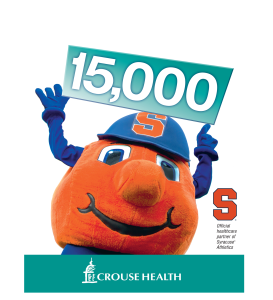Crouse Sets Standard for Robotic Surgery in Central New York: 15,000 Procedures Performed Since 2008
March 29, 2023
Home » News » Crouse Sets Standard for Robotic Surgery in Central New York: 15,000 Procedures Performed Since 2008

Crouse Health has reached a rare milestone in the field of minimally invasive surgery – 15,000 robotic-assisted procedures performed since the launch of the program in 2008.
Since that time the robotics program at Crouse has expanded to include seven robotic systems, with six da Vinci XI systems and the latest addition of a da Vinci Single Port (SP) system, the only one in Central New York. The program’s 27 surgeons provide the procedures and technology that support a variety of medical conditions in a wide range of specialty areas, including general, bariatric, colorectal, thoracic surgery, GYN oncology, gynecology and urology.
“Our surgeons have been pioneers in robotic-assisted surgery for 15 years. This achievement highlights Crouse’s regional leadership in minimally invasive robotic surgery and reflects our dedication to improving the lives of patients through leading-edge technology,” says Crouse President and CEO Seth Kronenberg, MD.
The da Vinci surgical system integrates robotics and extremely sophisticated computer technology with the skills of the surgeon. The system allows surgeons to see and move in three dimensions, giving them the ability to perform delicate operations with greater precision but requiring only tiny surgical openings. By avoiding the large incisions of open surgery, this computer-assisted micro-surgery helps avoid many post-surgical complications while shortening patient recovery time.
Crouse’s innovative da Vinci SP platform provides surgeons with robotic-assisted technology designed for access to tissue in the body with greater precision and enhanced mobility, all through a single port. Currently, the new robotic platform is being used for prostatectomy procedures, says Crouse Health urologist Po Lam, MD, who has more than 17 years of experience using the da Vinci robotic technology. “The ability to enter the body through a single, small incision helps surgeons perform procedures in a less invasive way, helping to reduce trauma and discomfort to the patient,” says Dr. Lam.
“We’re proud of the program we have built in collaboration with many of the region’s top surgeons and look forward to utilizing this innovative technology to continue to improve patient outcomes,” says Dr. Kronenberg.
For more information: crouse.org/robotics.
